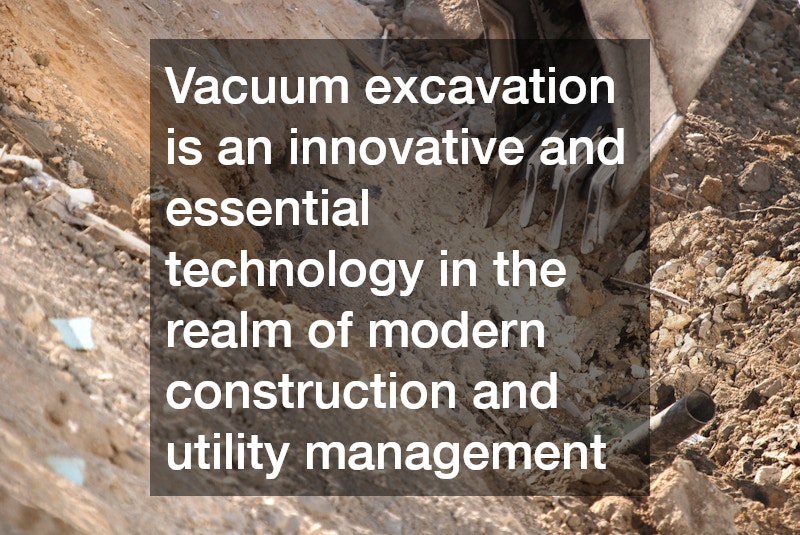Vacuum excavation, a lesser-known but incredibly powerful technology, is revolutionizing the way we approach digging and excavation projects. This method has gained popularity due to its efficiency and accuracy in preserving underground utilities while minimizing environmental disturbance.
As construction and infrastructure projects expand, understanding the essentials of vacuum excavation can be highly advantageous. Whether you’re a contractor, engineer, or simply curious about modern excavation methods, this overview will enlighten you about the benefits and applications of vacuum excavation.
How Vacuum Excavation Works
At its core, vacuum excavation relies on the principles of suction and pressure, providing a non-destructive method for excavating soil and debris. The process involves using high-powered air or water to loosen soil, which is then vacuumed through a hose into a debris tank. This precision allows operators to carefully expose underground utilities without causing damage to them. One significant advantage is the ability to safely dig around gas lines, water pipes, and telecommunications cables, where traditional digging methods might pose a risk. The technology’s capability to minimize accidental damage is a key reason for its increasing adoption in various sectors.
The Benefits of Vacuum Excavation
The benefits of vacuum excavation extend beyond its non-invasive nature and precise operation. This method is significantly faster than conventional excavation techniques, resulting in lower labor costs and expedited project timelines. It also produces less debris and dust, reducing the cleanup and restoration time required at the project site. Furthermore, vacuum excavation is environmentally friendly, as it minimizes disturbances to surrounding landscapes and ecosystems. These advantages make it an attractive option in urban areas, where preserving natural and built environments is of utmost importance.
Applications in Utility Location
One of the most critical applications of vacuum excavation is in utility location services. Before commencing any construction or excavation project, it’s essential to identify and map existing underground utilities accurately. Vacuum excavation provides a safe and non-destructive means of exposing these utilities, ensuring that projects can proceed without interruptions. The precision of vacuum excavation eliminates the risk of damaging existing utilities, which can lead to costly repairs and dangerous incidents. As infrastructure continues to age and expand, utility location through vacuum excavation becomes an indispensable tool for engineers and contractors.
Safety and Compliance Considerations
Safety is paramount in any excavation project, and vacuum excavation enhances this aspect by offering a controlled and precise method of digging. Working around buried utilities can be hazardous, especially in densely populated areas with complex underground networks. Vacuum excavation complies with safety regulations and guidelines, ensuring workers are protected from potential accidents. Many regions have embraced this technology as part of their standard excavation protocols, minimizing the risk of utility strikes and enhancing overall project safety. For construction companies, adopting vacuum excavation demonstrates commitment to high safety standards and regulatory compliance.
Future Prospects of Vacuum Excavation
The future of vacuum excavation looks promising as technological advancements continue to refine its capabilities. Innovations in suction technology, debris handling, and machine maneuverability are underway, aiming to enhance efficiency and reduce costs even further. As sustainable construction practices gain momentum, vacuum excavation aligns perfectly with the industry’s push towards environmentally friendly methods. Moreover, with the growing complexity of urban infrastructure, the demand for precise and non-destructive excavation solutions is set to rise. As more industries recognize the benefits and potential of vacuum excavation, its adoption is likely to increase, driving improvements and setting new standards in the field.
Vacuum excavation is an innovative and essential technology in the realm of modern construction and utility management. Its ability to deliver precise, safe, and environmentally friendly digging solutions makes it an indispensable tool for the industry. By understanding the workings, benefits, and applications of vacuum excavation, stakeholders can make informed decisions for their projects. This technology significantly reduces the risk of damaging existing underground utilities, enhances worker safety, and minimizes disruption to surrounding environments. Moreover, it aligns with growing demands for sustainable and responsible construction practices. As this technology continues to evolve, incorporating advancements in automation, efficiency, and adaptability, its role in shaping the future of excavation and infrastructure development will undoubtedly expand. From urban utility installations to large-scale infrastructure upgrades, vacuum excavation offers more efficient and sustainable solutions for the challenges of tomorrow. As regulations tighten and the need for smart, non-destructive digging increases, vacuum excavation stands out as a forward-thinking approach that meets both present and future demands.
.





